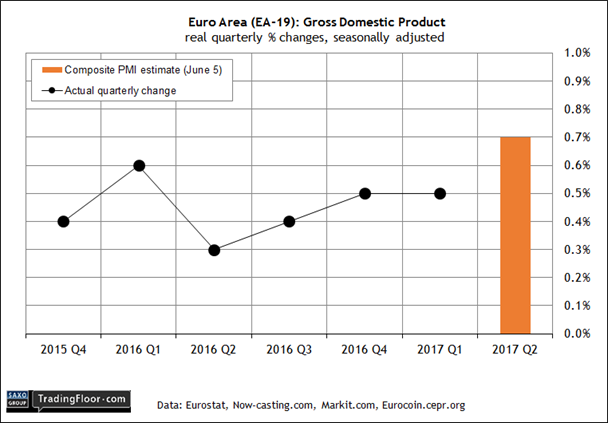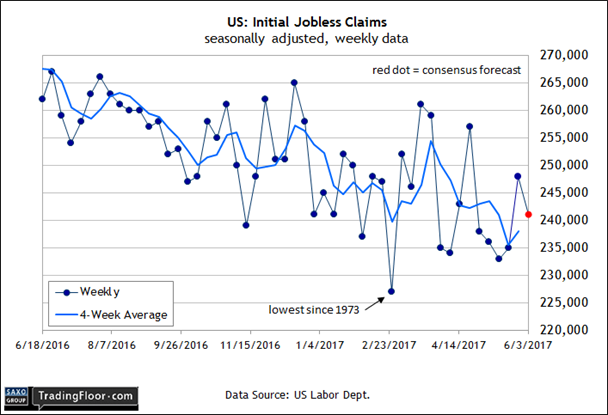- German industrial output on track to bounce back in April after falling in March
- Economists expect no change in monetary policy in today’s ECB announcement
- Analysts forecast that US jobless claims will slide for the week through June 3
Europe’s economy is front and centre in today’s schedule of releases, including the April report on industrial activity in Germany. Later, all eyes will turn to the European Central Bank, which publishes a new monetary policy statement followed by a press conference with ECB chief Mario Draghi.
For the US, the main event is the weekly release of initial jobless claims, which will be widely read in the wake of last week’s surprisingly soft employment report for May.
Germany: Industrial Production (0600 GMT): Factory orders in April fell by more than expected, but the outlook for Germany’s industrial sector – and the economy generally – remains encouraging.
April, however, was a rough month for new manufacturers’ orders. Economists were looking for a 0.4% decline; the actual change was a hefty 2.1% slide. But the volatile monthly change isn’t a reliable measure of the trend. By contrast, note that the year-on-year comparison picked up to a 3.3% increase (in seasonally and calendar adjusted terms) from a 2.4% advance in the previous month.
“Slight upward momentum in output and sales as well as a stellar business climate send strong signals for a continuation of the moderate upswing in manufacturing,” the Economy Ministry advised.
Today’s update on industrial activity for April is expected to underpin the Ministry’s optimism. Econoday.com’s consensus forecast sees production rising 0.6% for the month, marking a rebound after a 0.4% decline in March. The projected gain will likely keep output firmly in the black for the annual comparison.
Survey data also paint a bright profile for the sector. The Manufacturing PMI for May rose to its highest level in more than six years. “IHS Markit currently expects German industrial output to rise 2.9% in 2017 as a whole, up from growth of 1.0% in 2016,” an economist at the consultancy said last week.
Analysts expect that today’s hard data on industrial activity will reaffirm the bullish forecast.

Eurozone: European Central Bank Announcement (1145 GMT) and Press Conference (1230 GMT): Bloomberg’s report on Wednesday that the central bank will pare its inflation forecast took a bite out of the euro relative to the US dollar in early trading yesterday. But the single currency stabilised in mid-day trading for June 6: EUR/USD was changing hands at roughly 1.234, close to year-to-date highs.
Even if inflation turns out to be softer than expected in the euro area, the economic recovery still looks solid. The Eurozone Composite PMI is currently projecting a 0.7% increase in second quarter GDP, up from 0.5% in the first quarter. (Q1 GDP will be revised today at 0900 GMT, although the market is expecting that growth will hold at 0.5% for the first three months of the year.)
Economic activity may be picking up, but the European Central Bank is expected to keep its target rate unchanged today at 0%, according to Econoday.com’s consensus forecast. A downgrade for the inflation outlook will offer the ECB an extra layer of support for keeping rates unchanged while growth accelerates.
Nonetheless, the crowd will be listening carefully to the ECB’s press conference that follows the monetary announcement for any hints that the central bank is moving closer to squeezing policy in the months ahead. But for now, many analysts think that the ECB will continue its quantitative easing (QE) program – buying assets with newly minted money – well into next year.
Some forecasters say that the ECB in September will probably outline a plan to taper QE, with the goal of ending the program by the middle of next year. For today, however, hawkish commentary is expected to be minimal and sufficiently vague to give the central bank maximum wiggle room through the summer.
“The evidence so far is that [ECB President Mario] Draghi, until he starts seeing inflation, will remain cautious,” said the European strategist at Raymond James.

US: Initial Jobless Claims (1230 GMT): Employment growth in May was surprisingly soft, but the broader read on the labour market via the Conference Board’s Employment Trends Index (ETI) suggests that last month’s stumble was only a transient misstep.
ETI, which tracks eight employment indicators, ticked higher in May, which translates to a 6.4% increase vs. the year-earlier level. “While employment numbers have shown some softness in the past three months, there is no slowdown visible in the Employment Trends Index, suggesting solid job growth over the summer,” the consultancy’s chief economist for North America said earlier this week.
Today’s weekly update of new filings for unemployment benefits – one of ETI’s components – is expected to reaffirm the bullish outlook, based on Econoday.com’s consensus forecast. The crowd’s looking for claims to decline 7,000 to a seasonally adjusted 241,000 for the week through June 3 – close to the multi-decade low of 227,000 that was set in February.
If the projection is right, today’s release will strengthen the view that the weak employment report in May isn’t an early sign of trouble for the labour market or the broad US macro trend.

Disclosure: Originally published at Saxo Bank TradingFloor.com
